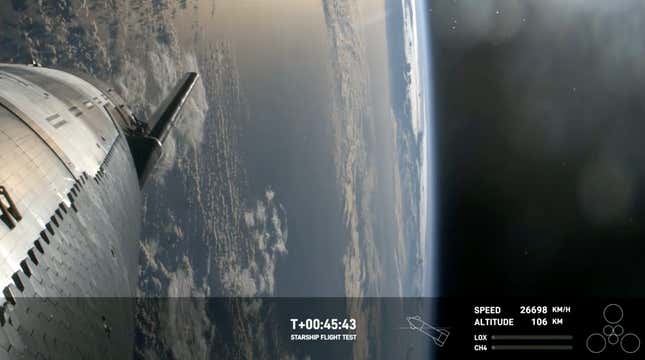
For the first time since the program began more than 10 years ago, SpaceX’s Starship actually feels like a real rocket. During today’s test, the megarocket achieved some notable objectives, including an extended flight in outer space.
This is a developing story and will be updated with new information.
With 33 Raptor engines revving at the same time, and powered by nearly 16 million pounds of thrust, the towering rocket lifted off from SpaceX’s Starbase facility in Boca Chica, Texas. The 110-minute launch window opened at 8:00 a.m. ET, with Starship finally taking off at 9:25 a.m. after multiple delays, one of which involved clearing boats from the designated exclusion zone. Propellant load finally began at approximately 8:35 a.m. ET.
The rocket managed to clear MaxQ (when aerodynamic stresses reached their peak) and survive stage separation. The Super Heavy booster fell back to Earth, and, unlike last time, managed to not explode. The plan was for the booster to perform a soft landing in the Gulf of Mexico with its 13 center Raptor engines firing, but only a few of them appeared to relight. SpaceX’s onboard video feed cut away from the booster at that critical juncture, as it smashed hard into the ocean. SpaceX will not attempt to recover the booster.

Meanwhile, the Starship upper stage continued on its journey through space, flying over the Caribbean on its intended path toward the Indian Ocean—its target landing location. It even managed to open and close its payload doors, and controllers initiated commands for a propellant transfer demo, marking important milestones as the rocket steadily advances toward operational readiness.
SpaceX lost contact with the upper stage, known as Ship 28, roughly one hour into the mission. It’s not clear at which stage Ship 28 failed, or the exact nature of the failure, but the spacecraft appears to have burnt up on reentry; the plan was for Starship to survive a controlled reentry and splash down in the Indian Ocean. Notably, an onboard camera showed an upsetting amount of debris in the vehicle’s vicinity prior to reentry, which will likely be an area of concern.
SpaceX has flown the fully integrated Starship on two prior occasions, April 20 and November 18 of last year. Each of these flights ended in explosions over the Gulf of Mexico, and each time the Federal Aviation Administration initiated a follow-up investigation. The most recent probe came to a close in late February, with the FAA issuing its Starship launch license late yesterday afternoon. SpaceX had to complete 17 corrective actions for the FAA before receiving clearance for Integrated Flight Test 3 (IFT-3). The regulator “determined SpaceX met all safety, environmental, policy and financial responsibility requirements,” according to an emailed statement from the FAA.

But IFT-3 felt different than the previous tests—the rocket seemed to be so much more in control. Sure, the booster crashed into the ocean, but that sets up a logical goal for the fourth test. SpaceX will pore over the data, learning from the good and the bad, and once again establish milestones for the subsequent test. The FAA may not have to open an investigation into IFT-3, unless it didn’t like the way the booster crashed (or some other issue), which means SpaceX should be able to proceed with the fourth test in short order.
The Elon Musk-led company employs an aggressive development process that often results in spectacular failures. “While it’s not happening in a lab or on a test stand, this is absolutely a test,” SpaceX said on X prior to launch. “What we’re doing today will provide invaluable data to continue rapid development of Starship.”
Related: Your comprehensive guide to NASA’s Artemis program
Indeed, the company is under increasing pressure to develop its over-sized reusable rocket system. SpaceX is under contract with NASA to leverage the Starship upper stage as a human landing system for upcoming Artemis missions to the Moon. Artemis 3, set to mark America’s first crewed lunar landing since 1972, is currently planned for late 2026.
Want to know more about Elon Musk’s space venture? Check out our full coverage of SpaceX’s Starship megarocket and the SpaceX Starlink internet satellite megaconstellation. And for more spaceflight in your life, follow us on X and bookmark Gizmodo’s dedicated Spaceflight page.






